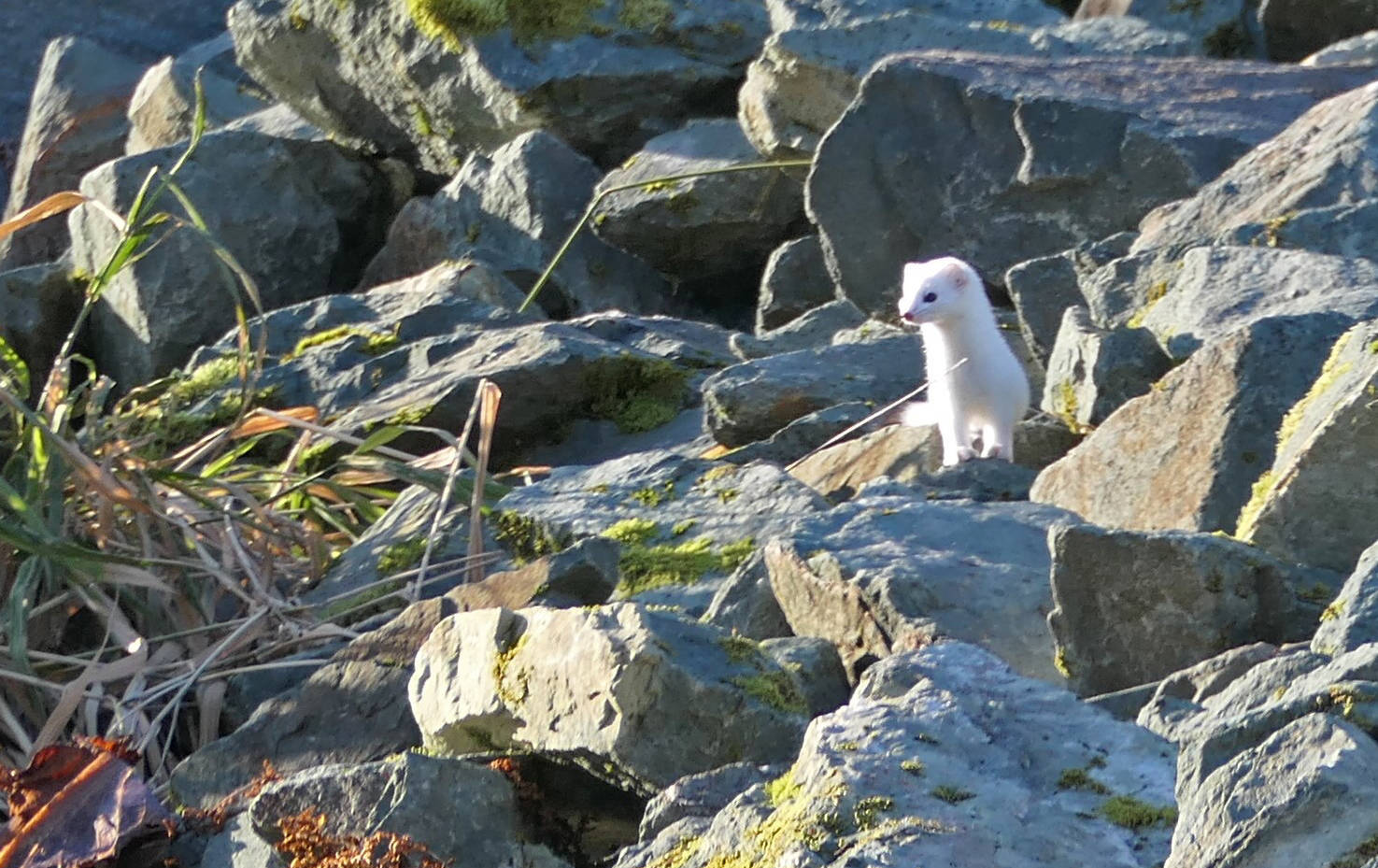Mary F. Willson
For the Juneau Empire
Days are rapidly getting shorter, and the peanut butter junkies at my feeders are voracious. The familiar Oregon juncos that thronged the feeders all summer are now scarce. But I’ve begun to see slate-colored juncos, here from the Interior for the winter. Closely related to the Oregon types — both are usually classed as subspecies of dark-eyed junco — but the new arrivals took at least a week to figure out how to exploit the peanut butter feeder. Maybe they watched the chickadees and got the idea.
On a lovely, sunny but cool and windy, day in mid-October, a little group of friends strolled up the road at Eaglecrest to go off onto the upper ski loop. Darting in and out of the angular rocks that line the road toward the Black Bear lift was a small white critter that disappeared almost as soon as it showed its head. So it took us a little time to ascertain who it was: of course, a short-tailed weasel or ermine (called a stoat in Europe). It then gave us many chances to see it as it explored both sides of the road, around the turn and past the Kimball memorial bench, popping up its head every so often to look around (and perhaps to check on us). The weasel was presumably hunting for something edible, such as a vole or shrew, but we saw no evidence of success.
The white winter fur was certainly conspicuous against a background of gray rocks and brown fern fronds. When there’s snow on the ground, of course it’s a different matter — the white fur is great camouflage then, only the black tail tip and a beady black eye marking the beast on a white background. “Our’ weasel apparently had turned its coat from summer brown to winter white well before snow would cover the ground (although a little dusting fell a few days later). Molt is said to be initiated by changes in photoperiod (day length), and modified by temperature, but southern ermine don’t change to white at all. In northern populations, the physiology of molting to winter color is not closely timed to reliable seasonal snow cover; in fact, on snow-free Haida Gwai’i, ermine still acquire a white winter coat. This leaves open a question about why molt is not better synchronized with background color everywhere.
Weasels are built long and slender, which enables them to slip into narrow tunnels, even into vole hideouts in pursuit of prey. However, that elongated body has a lot of surface area — where heat is lost — relative to body volume — where heat is generated — so weasels have a high metabolic rate that generates heat but necessitates lots of food. An active hunting style presumably provides more encounters with prey (than a sit-and-wait style, for instance), but has its own energetic costs. They need to eat several times a day (taking in about 30% of their body weight) and have a well-insulated nest (often stolen from a victim) in which to rest between hunts. If the usual prey of small rodents is scarce, weasels may hunt hares, squirrels, birds and even eat worms and bugs and carrion if necessary. They cache dead prey for future meals.
[Wild Shots: See photos of Mother Nature in Alaska]
Mating season is in spring, but fertilized eggs are not implanted in a female’s uterus until nine or 10 months later. Then, the embryos develop into babies in about a month, the newborns staying in the nest for a couple of months or so. Litter size is variable, usually four to eight kits, but well-fed females can produce much larger litters (up to 18 kits). Juvenile females become sexually mature while still in the natal nest and may (if a mature male was nearby) already carry fertilized eggs when they disperse to establish their own home ranges. Males can’t inseminate their female litter-mates because they don’t mature until about a year old.
Here are a few more interesting tidbits about weasels: They have excellent color vision, unlike most mammals. They climb well, with reversible ankle joints (like squirrels) so they can descend a tree head-first. If threatened by a superior predator, such as a cat, they may pretend to be dead; if not eaten, they quickly revive and run away.
At this time in October, there was a thin sheet of ice on my home pond in the morning and the ponds at Eaglecrest were ice-covered. Nevertheless, we saw caddisfly larvae in their cases, hanging out on the bottom of a few ponds or moving extremely slowly. They probably spend the winter as larvae, feeding on detritus when possible, but otherwise quiescent; pupation and metamorphosis into flying adults would occur the following year.
A few blueberries clung on their bushes, and I was informed that they were exceptionally tasty. The bright green fronds of deer fern and fern-leaf goldthread stood out on a background of brown, dead and dying vegetation. On the surface of some old skunk cabbage leaves, tiny pools of water had coalesced and frozen solid, forming jewel-like, nearly spherical beads that gleamed in the sunlight.
We ate our lunches in warm sunshine, all spread out in the lee of a grassy bank. The first wintery walk of the year turned out to be a good one.
• Mary F. Willson is a retired professor of ecology. “On The Trails” is a weekly column that appears in the Juneau Empire every Wednesday.

